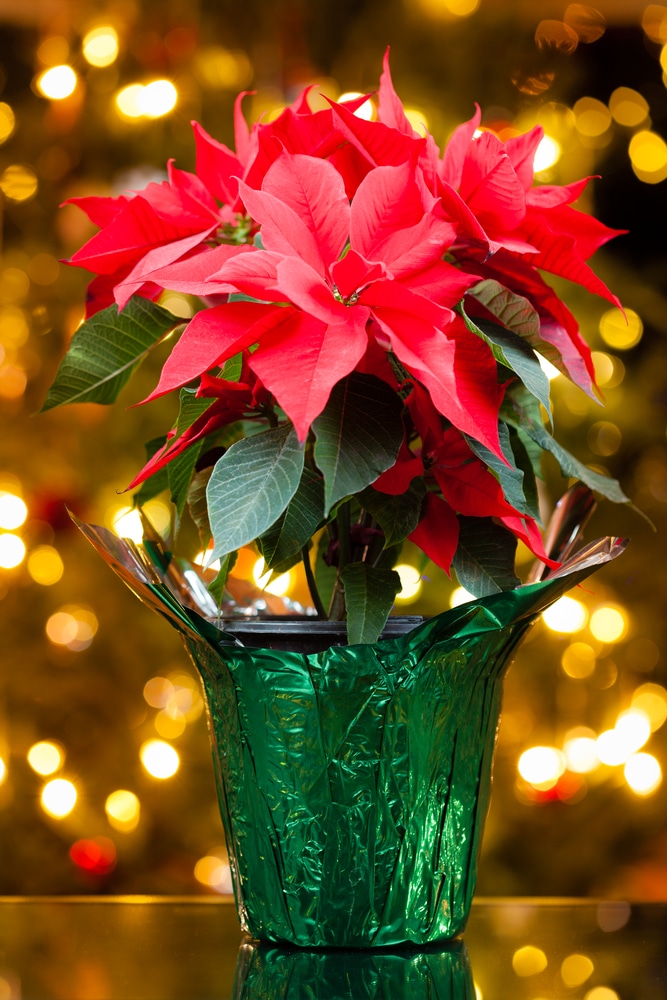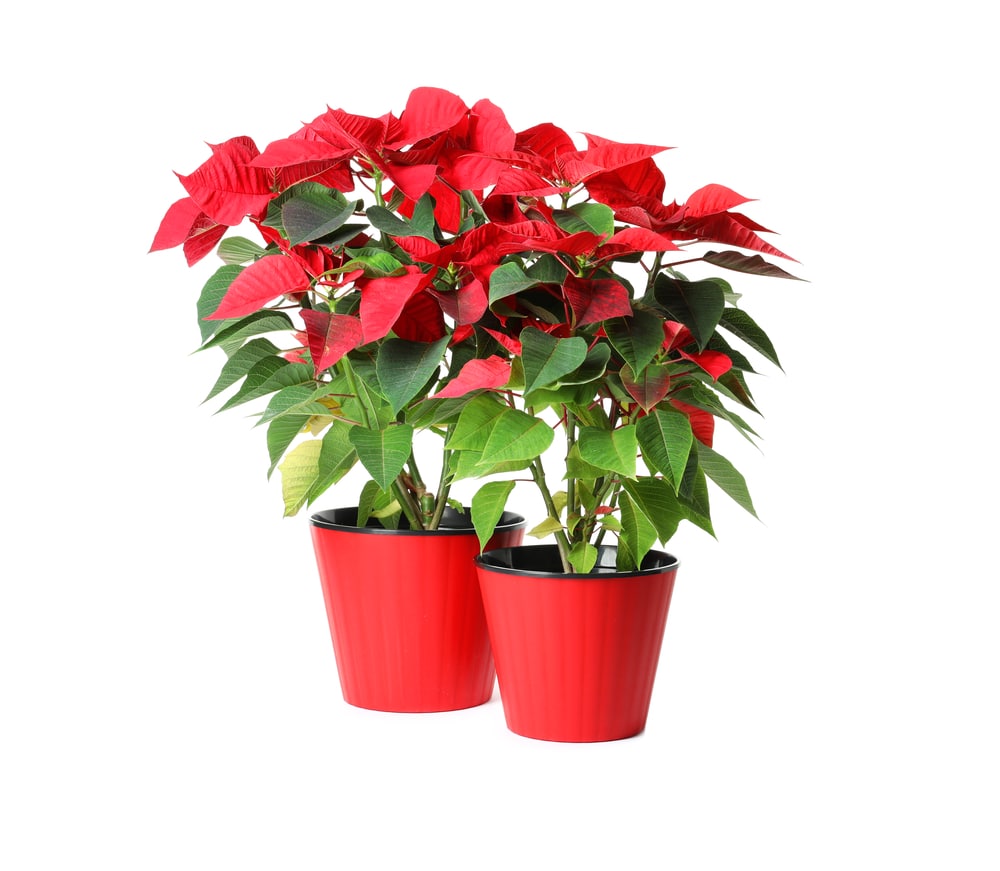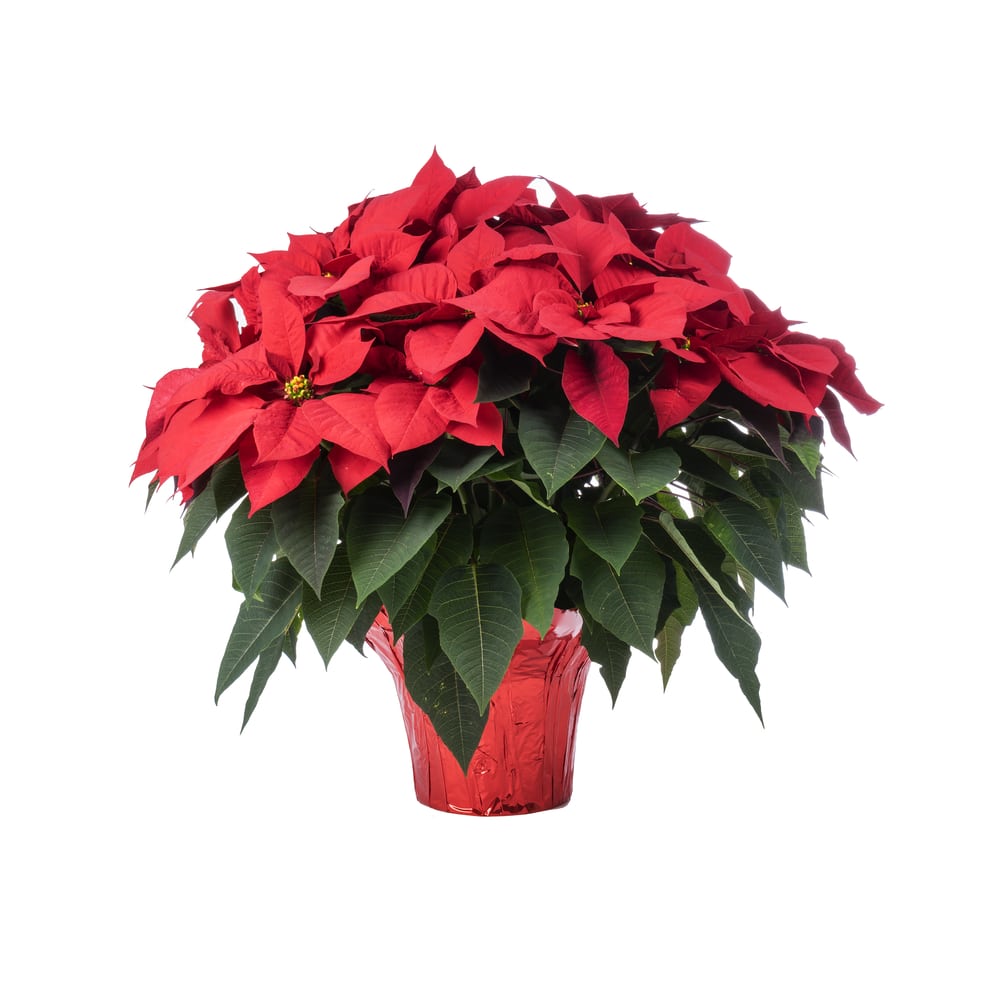Poinsettias are a classic holiday plant that instantly evoke feelings of Christmas and the winter season. With their bright red or white bracts, poinsettias add festive flair wherever they are displayed.
But keeping these finicky tropical plants looking their best through the holidays and beyond takes a bit of special care, especially when it comes to watering. And one watering method you may have heard about is placing ice cubes directly into the soil.
This idea has spread widely on the internet, recommended on thousands of sites. But is watering poinsettias with ice really effective? Or is it just an urban myth that sounds good in theory but doesn’t work well in practice?
Today, we’re going to talk about the pros and cons of watering poinsettias with ice. We’ll talk about why some people suggest this strange method and why most experts say you shouldn’t use it.
The Theory Behind Using Ice Cubes
To begin, let us look at why some people believe that ice cubes are a good way to water poinsettias.
The main idea is that the ice melts slowly releasing a small amount of water into the soil over time. This is supposed to be a convenient way to provide the plant with frequent small drinks of water.
Since poinsettias prefer moderately moist, but not soggy soil, some believe giving them tiny sips of water from melting ice cubes is ideal. This mimics frequent tropical rains.
Plus, ice cube proponents say you don’t have to worry about overwatering. The ice melts too slowly to make the soil waterlogged.
This hands-off watering method certainly sounds easy. Putting a few ice cubes on the soil every day will keep your poinsettia perfectly moist. Right?.
Unfortunately, most horticulture experts say it just doesn’t work this smoothly in real life. And they advise against using ice to water poinsettias or other houseplants.
Why Experts Don’t Recommend Ice Cubes
While it seems logically that ice cubes would provide gradual, even watering, experts say that in practice this method causes more problems than it solves.
Here are some of the main reasons why ice cubes often fail to properly hydrate poinsettias:
-
Inconsistent moisture: Ice melts unpredictably, wetting some parts of the soil while leaving other areas dry. This leads to uneven, spotty moisture.
-
Insufficient water: A few small ice cubes don’t provide enough total water for the plant’s needs.
-
Troublesome temperature shock: Ice cubes may damage roots and stems when they directly touch them.
-
Inconvenient daily task: You must refill ice cubes every day for continuous watering.
-
Overwatering risk: If you use too many cubes, the excess melted water can’t drain properly.
-
Drought stress: Between ice cube refills, poinsettias may wilt from inadequate water.
-
No adjustments for conditions: The fixed rate of ice melting doesn’t account for environmental factors that change the plant’s water needs.
These issues lead to struggling, unhealthy poinsettias. Why not use ice instead? What’s the best way to water them?
Simple, Effective Watering Method
Rather than using ice cubes, follow these easy tips for watering poinsettias properly:
-
Check soil moisture daily by touching the top few inches of soil. Water whenever it feels dry.
-
Water thoroughly until excess drips out the bottom of the pot. This ensures the whole root zone gets hydrated.
-
Remove any decorative foil or plastic sleeve before watering. This allows drainage.
-
Let extra water collect in a saucer beneath the pot. The plant will absorb it back.
-
Give houseplants room temperature water, not cold from the tap.
-
Avoid getting water on poinsettia leaves and flowers, which can promote leaf spot diseases.
-
Don’t let poinsettias wilt severely between waterings. Wilting stresses the plant.
-
Water in the morning so leaves dry quicker. Wet foliage at night encourages disease.
Following these simple rules will keep your poinsettia’s soil evenly moist without overwatering. The plant will be able to thrive and look beautiful through the holiday season.
When Ice Cubes Can Work
While ice cubes generally aren’t an ideal way to water poinsettias, there are a few situations where they may be helpful:
-
If you’ll be traveling and unable to water normally, ice cubes can tide plants over for a few days.
-
In an exceptionally warm, dry room, the slow melting of ice may work better than normal watering.
-
For a poinsettia in a small pot, ice cubes can supplement regular watering.
-
Use ice to boost humidity for poinsettias, not directly stick in soil. The cold won’t damage leaves like roots.
So ice isn’t necessarily forbidden, but only use it sparingly in certain circumstances, not as the sole water source.
Keep Holiday Plants Looking Their Best
Now that you know why ice cubes often fail at watering poinsettias properly, you can avoid this questionable technique. With the simple, effective method outlined here, you’ll succeed in keeping your holiday poinsettias looking lush, healthy, and vibrant all season long.
Proper watering is just one important care tip for poinsettias and other popular Christmas plants like Christmas cactus, cyclamen, amaryllis, and paperwhite narcissus. Be sure to give all your holiday plants the conditions they require for maximum enjoyment. With just a little attention, they’ll reward you with their colorful, festive beauty.

How Often to Water Poinsettias
This is the most common question when it comes to poinsettias: how often do they need to be watered? This is a great question because the last thing you want to deal with is root rot that comes from giving your plant too much water (the fastest way to kill it!).
A general rule of thumb when it comes to watering poinsettias is to water them when the top inch of the soil feels dry. For best results, check your plant for water every day to every few days; you don’t want to forget about this one.
Keep in mind that the dry, warm air from indoor heaters can strip the soil of moisture fairly quickly.
Don’t be intimidated though, as watering is pretty simple: if the surface of the soil feels dry, it’s time to break out your watering can and water your plant!.
Always keep in mind that the soil should never ever be soggy. This Christmas flower appreciates well-draining soil and doesn’t like excess moisture or sitting in a pool of water. Your poinsettia pot should never be water-logged.
This is why good drainage is so important!

Your pot should have a drainage hole where excess water can drain each time you water it. If your pot does not have a drainage hole at the bottom, it’s best to poke one through, otherwise, you’ll soon start to notice things like root rot and leaf drop.
Another good way to know when it’s time to water poinsettias is by paying attention to the weight of the pot, which changes as the soil dries out.
The drier the soil gets, the lighter the pot will feel when you pick it up. A pot that still has a good weight to it probably has sufficient moisture in the soil. A pot that feels incredibly light means the soil has been stripped of most of its moisture.
It’s also important to remember that poinsettias and succulents both like it when the soil dries out a bit between waterings. You want the soil to be a little loose before you water it again; don’t always keep it dense.
Usually, poinsettias will need to be watered every other day to every three days. So, expect to water about two to three times a week.

How to Water Poinsettias
Now that you know how often you should water this plant during the winter months, it’s time to quickly cover HOW to water it. It’s very straightforward!.
You can do it two ways:
After you fill up your watering can, grab your pot and take it off the foil that was used to cover it for looks.
Water the soil directly, drenching it until you can see water spilling out of the pot from the drainage hole.
Then, let it sit for a few minutes before placing it back in the decorative foil.
If you don’t want to use a watering can, the kitchen skin will do! Simple place the plant in the sink and under the spout. Make sure to use light water pressure so as to not splash soil all over your kitchen sink!
Either way, always use room temperature water; cold water can shock this tropical plant, just like cold drafts and a cold window can (remember their naturally warm environment!

How To Water Poinsettias
FAQ
Should you water poinsettias with ice cubes?
Some people like to put ice cubes on top of plant soil and water the plant as the cubes melt. For poinsettias, this is not a good idea. Dec 20, 2024.
Does watering plants with ice cubes work?
Not only will the slow-melting ice allow the plant roots to suck up the amount of water it needs, but it also allows you to consistently water your plant the right amount. This method also works great to water plants that are out of reach.
How do I make my poinsettia last longer?
Place them in a light-filled room away from drafts. At night, they do best in rooms that are 55 to 65 F and during the day, 65 to 70 F.
